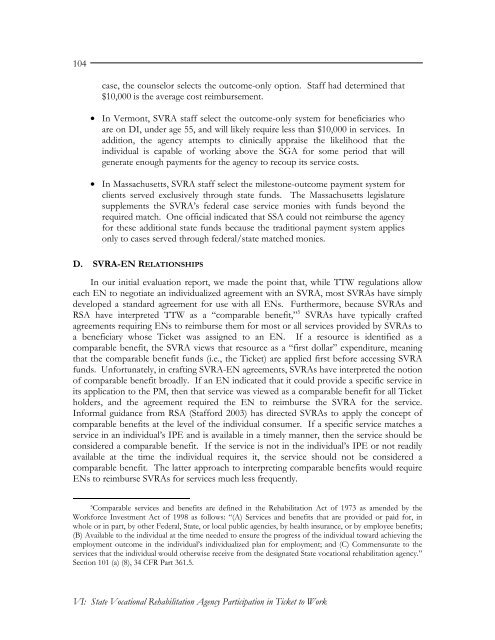Evaluation of the Ticket to Work Program, Implementation ...
Evaluation of the Ticket to Work Program, Implementation ...
Evaluation of the Ticket to Work Program, Implementation ...
You also want an ePaper? Increase the reach of your titles
YUMPU automatically turns print PDFs into web optimized ePapers that Google loves.
104case, <strong>the</strong> counselor selects <strong>the</strong> outcome-only option. Staff had determined that$10,000 is <strong>the</strong> average cost reimbursement.• In Vermont, SVRA staff select <strong>the</strong> outcome-only system for beneficiaries whoare on DI, under age 55, and will likely require less than $10,000 in services. Inaddition, <strong>the</strong> agency attempts <strong>to</strong> clinically appraise <strong>the</strong> likelihood that <strong>the</strong>individual is capable <strong>of</strong> working above <strong>the</strong> SGA for some period that willgenerate enough payments for <strong>the</strong> agency <strong>to</strong> recoup its service costs.• In Massachusetts, SVRA staff select <strong>the</strong> miles<strong>to</strong>ne-outcome payment system forclients served exclusively through state funds. The Massachusetts legislaturesupplements <strong>the</strong> SVRA’s federal case service monies with funds beyond <strong>the</strong>required match. One <strong>of</strong>ficial indicated that SSA could not reimburse <strong>the</strong> agencyfor <strong>the</strong>se additional state funds because <strong>the</strong> traditional payment system appliesonly <strong>to</strong> cases served through federal/state matched monies.D. SVRA-EN RELATIONSHIPSIn our initial evaluation report, we made <strong>the</strong> point that, while TTW regulations alloweach EN <strong>to</strong> negotiate an individualized agreement with an SVRA, most SVRAs have simplydeveloped a standard agreement for use with all ENs. Fur<strong>the</strong>rmore, because SVRAs andRSA have interpreted TTW as a “comparable benefit,” 5 SVRAs have typically craftedagreements requiring ENs <strong>to</strong> reimburse <strong>the</strong>m for most or all services provided by SVRAs <strong>to</strong>a beneficiary whose <strong>Ticket</strong> was assigned <strong>to</strong> an EN. If a resource is identified as acomparable benefit, <strong>the</strong> SVRA views that resource as a “first dollar” expenditure, meaningthat <strong>the</strong> comparable benefit funds (i.e., <strong>the</strong> <strong>Ticket</strong>) are applied first before accessing SVRAfunds. Unfortunately, in crafting SVRA-EN agreements, SVRAs have interpreted <strong>the</strong> notion<strong>of</strong> comparable benefit broadly. If an EN indicated that it could provide a specific service inits application <strong>to</strong> <strong>the</strong> PM, <strong>the</strong>n that service was viewed as a comparable benefit for all <strong>Ticket</strong>holders, and <strong>the</strong> agreement required <strong>the</strong> EN <strong>to</strong> reimburse <strong>the</strong> SVRA for <strong>the</strong> service.Informal guidance from RSA (Stafford 2003) has directed SVRAs <strong>to</strong> apply <strong>the</strong> concept <strong>of</strong>comparable benefits at <strong>the</strong> level <strong>of</strong> <strong>the</strong> individual consumer. If a specific service matches aservice in an individual’s IPE and is available in a timely manner, <strong>the</strong>n <strong>the</strong> service should beconsidered a comparable benefit. If <strong>the</strong> service is not in <strong>the</strong> individual’s IPE or not readilyavailable at <strong>the</strong> time <strong>the</strong> individual requires it, <strong>the</strong> service should not be considered acomparable benefit. The latter approach <strong>to</strong> interpreting comparable benefits would requireENs <strong>to</strong> reimburse SVRAs for services much less frequently.5 Comparable services and benefits are defined in <strong>the</strong> Rehabilitation Act <strong>of</strong> 1973 as amended by <strong>the</strong><strong>Work</strong>force Investment Act <strong>of</strong> 1998 as follows: “(A) Services and benefits that are provided or paid for, inwhole or in part, by o<strong>the</strong>r Federal, State, or local public agencies, by health insurance, or by employee benefits;(B) Available <strong>to</strong> <strong>the</strong> individual at <strong>the</strong> time needed <strong>to</strong> ensure <strong>the</strong> progress <strong>of</strong> <strong>the</strong> individual <strong>to</strong>ward achieving <strong>the</strong>employment outcome in <strong>the</strong> individual’s individualized plan for employment; and (C) Commensurate <strong>to</strong> <strong>the</strong>services that <strong>the</strong> individual would o<strong>the</strong>rwise receive from <strong>the</strong> designated State vocational rehabilitation agency.”Section 101 (a) (8), 34 CFR Part 361.5.VI: State Vocational Rehabilitation Agency Participation in <strong>Ticket</strong> <strong>to</strong> <strong>Work</strong>
















